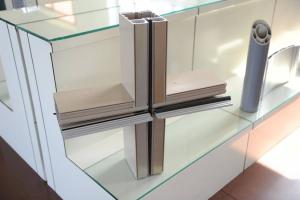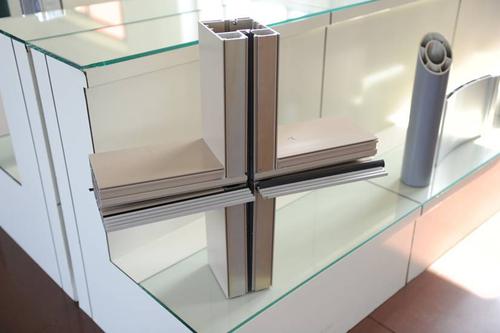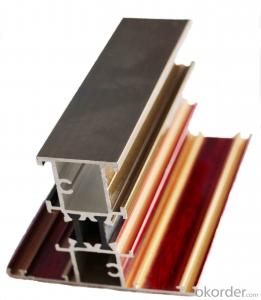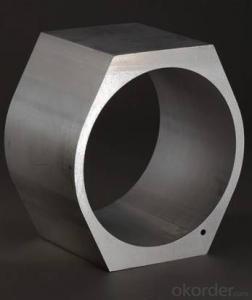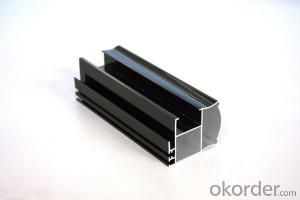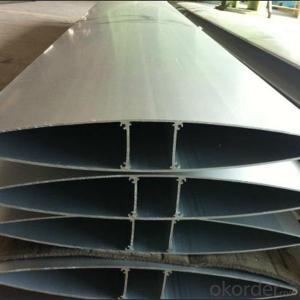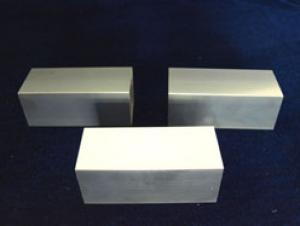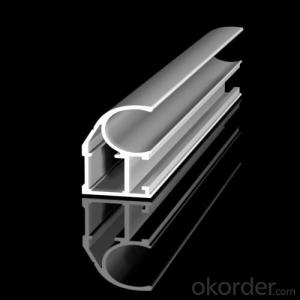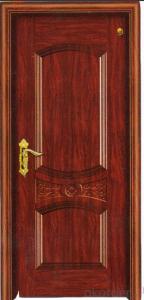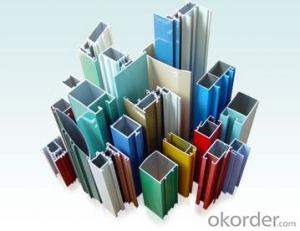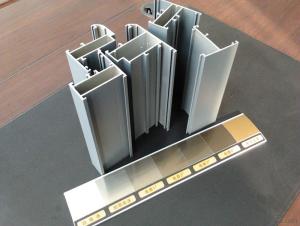Wholesale Anodized Aluminum Profiles for Window and Door
- Loading Port:
- China Main Port
- Payment Terms:
- TT OR LC
- Min Order Qty:
- -
- Supply Capability:
- -
OKorder Service Pledge
OKorder Financial Service
You Might Also Like
Specification:
1. Alu Alloy: 6063, 6061, 6005
2. State: T5/T6
3. Length: 1m-7m
4. Normal Anodizing thickness: 8-12 micro
5. Normal powder coating thickness: 80-120 micro
6. Tensile strength: ≥ 160 mpa
7. Yield strength: ≥ 110 mpa
8. Extensibility: ≥ 8%
9. Hardness(HW):8-14HW
Packing:
EPE Fram, Shrink film, Composite paper + Kraft paper
Aluminum profile application:
1. Industrial profiles;
2. Decoration/Furniture profiles;
3.Construction/Building profiles,Aluminum Pipes and tubes;
4. Door&Window profiles;
5. Curtain Wall profiles;
6. Aluminum Heat Sink;
7. Aluminum Angle/Channels;
8. LED panel etc.
Strong resistance corrosion property, effectively prevent acid, alkali, and salt etc.
Smooth and subtle, vivid, bright, and magnificent appearance
Alloy: 6063
Finish: anodizing, electrophoretic coating, powder coating, wood effect etc according to customers’ need
Standard package: suitable for long ocean transporting
OEM&ODM is welcome
Last for life time
- Q: How can the aluminum profile T6 and T5 be distinguished?
- Hardness is generally measured by a Brinell hardness tester. T5 is subjected to high temperature molding and air cooling quenching in the shortest possible time. The T6 is treated with solid solution after artificial aging. So there is a difference between the two. But from the appearance of it is difficult to judge, experienced hands can be used to swing aluminum, roughly judged
- Q: This question asks for methods to avoid corrosion on aluminum profiles during the installation process.
- <p>To prevent corrosion on aluminum profiles during installation, follow these steps: Use high-quality aluminum that has a protective oxide layer. Ensure the installation environment is dry and clean. Avoid contact with corrosive substances like acids or alkalis. Apply a protective coating or sealant if the profiles will be exposed to harsh environments. Use stainless steel or corrosion-resistant fasteners. Regularly inspect and clean the profiles to remove any dirt or debris that could lead to corrosion. Proper installation techniques and maintenance can significantly reduce the risk of corrosion on aluminum profiles.</p>
- Q: Can aluminum profiles be used in the production of laboratory equipment?
- Yes, aluminum profiles can be used in the production of laboratory equipment. Aluminum is a versatile and widely used material in various industries, including laboratory equipment manufacturing. Aluminum profiles offer several advantages for laboratory equipment production. Firstly, aluminum is lightweight yet strong, making it ideal for constructing equipment that needs to be portable or moved frequently within the laboratory. Its lightweight nature also reduces the strain on laboratory personnel when handling and transporting the equipment. Secondly, aluminum profiles can be easily shaped and molded into various forms and sizes, allowing for the customization of laboratory equipment to meet specific requirements. This flexibility in design enables the production of equipment with complex shapes and structures, ensuring optimal functionality and efficiency. Additionally, aluminum is corrosion-resistant, which is crucial in laboratory settings where exposure to chemicals and liquids is common. This property helps to extend the lifespan of the equipment and ensures it remains in good condition even after prolonged use. Furthermore, aluminum profiles can be anodized or coated to provide additional protection against wear, scratches, and other types of damage. This makes the equipment more durable and easier to clean, maintaining the required hygiene standards in laboratories. Lastly, aluminum is a highly conductive material, making it suitable for applications that require heat transfer or electrical conductivity. This property is advantageous for laboratory equipment such as heating plates, heat sinks, or electrical circuit components. In conclusion, aluminum profiles can indeed be used in the production of laboratory equipment. Their lightweight, malleable, corrosion-resistant, and conductive properties make them a suitable choice for manufacturing various types of laboratory equipment, ensuring durability, functionality, and ease of use.
- Q: This question asks about the various surface treatments or finishes that can be applied to aluminum extrusions, which are shaped profiles made from aluminum.
- <p>Aluminum extrusions can be finished in several ways to enhance their appearance, durability, or functionality. Common finishes include anodizing, which provides a protective oxide layer; powder coating, offering a wide range of colors and textures; painting, which can be done electrostatically or by hand; polishing, resulting in a shiny, smooth surface; brushing, which creates a satin-like finish; and chromate conversion coating, which is a pretreatment for further painting or coating. Other finishes include wood grain transfer, which gives an aluminum surface a wood-like appearance, and various types of protective films or laminates. Each finish serves different purposes, from improving aesthetics to increasing corrosion resistance.</p>
- Q: Who can tell me the latest national standard for aluminum and the latest edition, -2008?
- Standard number: GB 21351-2008Standard Name: energy consumption quota for aluminum alloy building profile products per unitStandard status: currentEnglish: The, norm, of, energy, consumption, per, unit, product, of, wrought, aluminium,, alloy, extruded, architecture, profiles, for,...Date of implementation: 2008-6-1Promulgated by the Ministry of State Administration of quality supervision, inspection and Quarantine of the People's Republic of China, China National Standardization AdministrationBrief introduction: this standard specifies the Aluminum Alloy profile building energy consumption per unit product of the technical requirements, the scope of statistics and calculation method, calculation range and energy saving management measures. And the calculation and assessment of this standard applies to the enterprise energy consumption per unit product of Aluminum Alloy section building, and the consumption of the new project control.
- Q: What is the difference between aluminum alloy and 6063-T5 6060-T66?
- 6060-T66, higher strength, average mechanical performance is higher than T6 under 20-30Mpa condition [T66 is in T6 (solid solution strengthening + fully artificial aging) condition, strengthened by special process status - in European standard can be found] 6063-T5 is the most common aluminum alloy and delivery condition, and most of the architectural profiles are applied
- Q: What is a pouring type heat insulation aluminum profile?
- Pouring type thermal insulation aluminum profile is put into the liquid insulation curing Aluminum Alloy section casting trough and resection, Aluminum Alloy section casting trough Pro bridge connecting through the broken metal insulation material Aluminum Alloy insulation two combined composite material.
- Q: This question asks for a list of various fastening methods or components used to attach aluminum profiles in roofing systems.
- <p>In roofing systems, various types of fasteners are used to secure aluminum profiles, ensuring stability and longevity. Some common fasteners include: 1. Self-tapping screws, which thread directly into the aluminum without pre-drilling. 2. Rivets, which join two pieces of aluminum by compressing them together. 3. Nuts and bolts, used in conjunction with pre-drilled holes for a secure fit. 4. Clamps, which hold profiles together without penetrating the material. 5. Adhesives, used for bonding profiles in situations where mechanical fasteners are not suitable. 6. Clips and brackets, which can be used to attach profiles to other structural elements. Each type of fastener has its specific application and is chosen based on the design requirements and environmental conditions of the roofing system.</p>
- Q: Are aluminum profiles resistant to termites and insects?
- Yes, aluminum profiles are highly resistant to termites and insects. Unlike wood, which is susceptible to termite infestations and insect damage, aluminum is a nonporous material that does not provide a food source for these pests. Additionally, aluminum profiles are typically coated with protective finishes, such as powder coating or anodizing, which further enhance their resistance to termites and insects. This makes aluminum profiles a durable and long-lasting option for various applications, such as window frames, door frames, and other construction projects where termite or insect damage is a concern.
- Q: Are aluminum profiles suitable for use in exterior wall insulation systems?
- <p>Yes, aluminum profiles can be used for exterior wall insulation systems. They are known for their durability, resistance to corrosion, and ability to withstand various weather conditions. Aluminum profiles provide a strong structural framework that can support insulation materials effectively. They are also lightweight, which makes them easy to handle and install. Additionally, aluminum profiles can be anodized or coated to enhance their resistance to environmental factors, making them a popular choice for exterior insulation systems.</p>
Send your message to us
Wholesale Anodized Aluminum Profiles for Window and Door
- Loading Port:
- China Main Port
- Payment Terms:
- TT OR LC
- Min Order Qty:
- -
- Supply Capability:
- -
OKorder Service Pledge
OKorder Financial Service
Similar products
Hot products
Hot Searches
Related keywords
